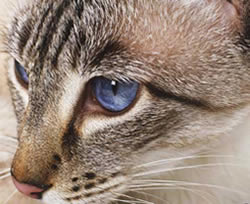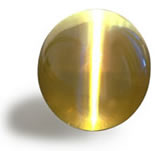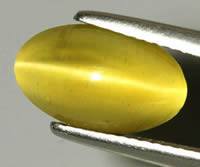|
|
Your Details
|
|
Your Details
|
Reviewed By Andreas Zabczyk
Cat's Eye Gemstones
A Real Cat's Eye
Cat's eye gemstone is particularly fascinating among those that exhibit unique optical effects, primarily because this phenomenon can be found in a variety of gemstone types. The term for this striking effect is chatoyancy, which comes from the French phrase "œil de chat," meaning "eye of the cat. Discover our extensive range of loose cat's eye gemstones for sale, featuring a wide range of types and prices. The chatoyant effect resembles, appropriately enough, the slit eye of a cat. The effect is caused by the reflection of light by parallel fibers, needles or channels in the gemstone. Usually the gemstone needs to be cut en cabochon with the base parallel to the fibers for this effect to be displayed. When the gem is rotated, the cat's eye appears to glide over the surface. The chatoyant effect is similar to asterism (the star effect), except there is one straight ray instead of four or six. Occasionally a cat's eye with two parallel rays can be seen. 
Natural Chrysoberyl Cat's Eye
The most famous and valuable cat's eye gemstone is chrysoberyl cat's eye. In fact when the term cat's eye is used alone in the gem trade, it always refers to chrysoberyl cat's eye. All other types of cat's eye gems require an additional varietal designation, such as cat's eye apatite. Chrysoberyl cat's eye belongs to the same family as the rare alexandrite. Since chrysoberyl is a very hard stone (8.5 on Mohs gemstone hardness scale), it is suitable for all kinds of jewelry. Chrysoberyl cat's eye is found in Sri Lanka, Brazil, India, China and Zimbabwe. The cat's eye effect can be found in a number of other gem varieties, though in some cases the effect is quite rare. Among the finer gemstones, cat's eye tourmaline can often be found in green and pink, and larger sizes are not uncommon. With a hardness of 7 to 7.5 on the Mohs scale, cat's eye tourmaline is durable enough for rings. Several quartz varieties are well-known for their chatoyant effects. The most famous is so-called tiger's eye. Found in gold-yellow and gold-brown, it is first formed as the fibrous blue mineral called crocidolite, which is made up of iron and sodium. The crocidolite was gradually transformed into quartz while maintaining its fibrous formations. 
Natural Cat's Eye Apatite
Among the softer gemstones, the cat's eye effect is often found in the gemstone apatite, in a golden color somewhat reminiscent of chrysoberyl. It can also be found in colorless, pink, yellow, green, blue and violet. But with a hardness of only 5 on the Mohs scale, cat's eye apatite is most suitable for pendants, brooches and earrings. The cat's eye effect can also be seen in a number of other gem varieties, but only very rarely. They include emerald, iolite (also known as cordierite), aquamarine, andalusite, tanzanite and scapolite. These are real collector's items. |
